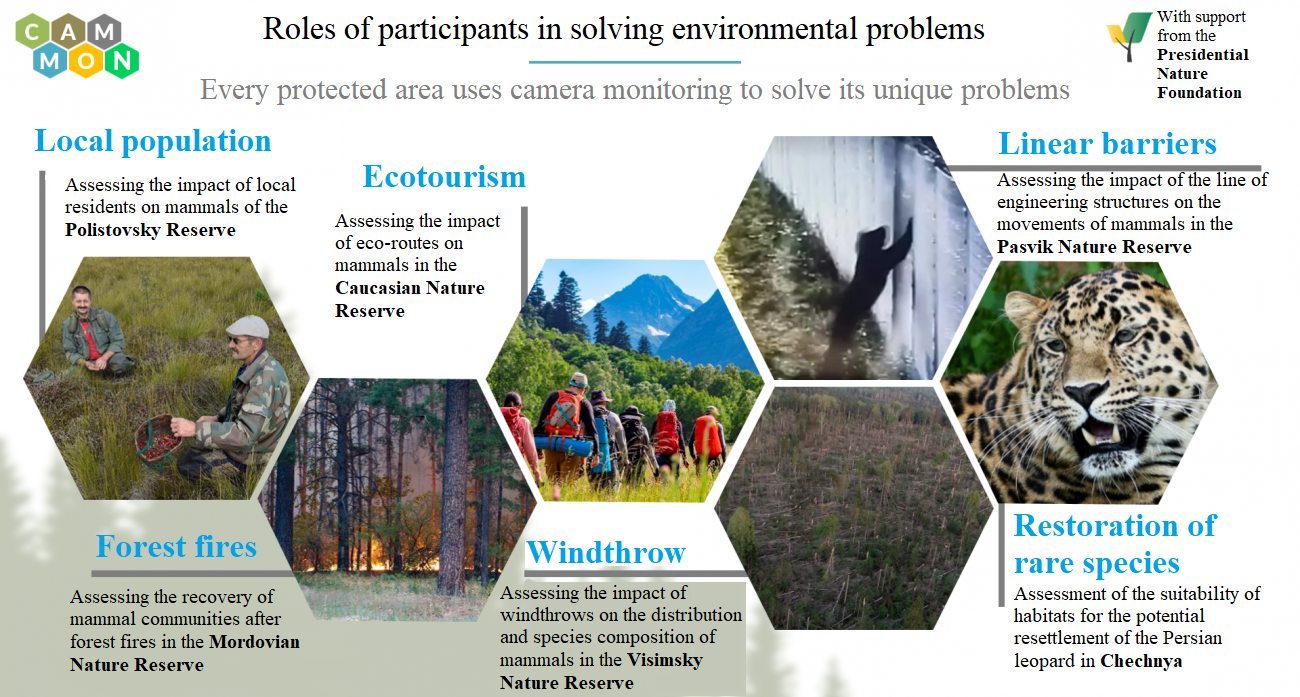
Seven Russian nature reserves are creating the country's first unified wildlife photo-monitoring network. The project, initiated by the Central Forest Nature Reserve, has received grant support from the Presidential Fund for Nature and has begun operations.
Sergey Ogurtsov, the project's director and leading researcher at the Central Forest Nature Reserve, explains its main goal: "Russia has long needed to create a unified data center to accumulate photos and videos from camera traps collected in various protected areas. Such a center will enable meta-analysis, the results of which will be significant at the national level. This is crucial for preserving our country's biodiversity, as well as its environmental and intellectual security. Camera traps are used to monitor biodiversity in many Russian protected areas, but until now, there has been no unified approach to organizing such observations. This makes it virtually impossible to compare data collected in different areas. In 2022, the first national photo-monitoring program, CAMMON (CAMtrap MONitoring), was developed, enabling comprehensive observations of various mammals, as well as plants and inanimate natural phenomena. Thanks to the Presidential Fund for Nature, our work will allow us to test the Program's capabilities in various ecogeographical conditions (from the forest-tundra of the Far North to the Caucasus Mountains), evaluate 12 parameters characterizing the state of mammal populations at the systemic level, demonstrate the high effectiveness of photomonitoring in solving various applied environmental problems, and utilize the obtained results in the social sphere through environmental education.”
The project aims to create a unified system for monitoring biodiversity using camera traps and a common methodology. Seven protected areas are participating in the project: Polistovsky Nature Reserve (Pskov Region), Mordovsky Nature Reserve (Republic of Mordovia), Pasvik Nature Reserve (Murmansk Region), Visimsky Nature Reserve (Sverdlovsk Region), Kavkazsky Nature Reserve (Western Caucasus), Sovetsky Federal Wildlife Refuge (Chechen Republic), and the Central Forest Nature Reserve (Tver Region, hereinafter CFNR), which initiated the project. Each of the seven protected areas will address its own specific objectives within the project. Polistovsky Nature Reserve will organize interactions with local residents by assessing their impact on mammals within the reserve and the protected zone. Mordovsky Nature Reserve will begin monitoring the recovery of mammal communities after fires. Pasvik Nature Reserve will assess the impact of engineering structures on mammal migration. The Visimsky Nature Reserve will study how windfalls affect mammal populations in the mosaic landscapes of the Middle Ural lowlands. The Kavkazsky Nature Reserve will be able to observe the impact of mass tourism and resort development on mammals and develop mitigation mechanisms. The Sovetsky Federal Nature Reserve, supervised by specialists from the A.N. Severtsov Institute of Ecology and Evolution of the Russian Academy of Sciences (IEE RAS), will assess the habitat suitability for the reintroduction of the Persian leopard as part of its restoration program in the Russian Caucasus. Importantly, all of them will work using a unified methodology, actively exchange data, and publicly share successes, challenges, and observations throughout the project.

"Since 2007, the A.N. Severtsov Institute of Ecology and Evolution of the Russian Academy of Sciences (IEE RAS), with the participation of colleagues from the A.K. Tembotov Institute of Mountain Ecology of the Russian Academy of Sciences (IEMT RAS), the Caspian Institute of Biological Resources of the Dagestan Federal Research Center of the Russian Academy of Sciences (CIBR DFRC RAS), as well as zoologists from the Moscow Zoo, the Caucasus Nature Reserve, the North Ossetian Nature Reserve, the Alania National Park, and the Elbrus National Park, has been providing scientific support for the Program for the Restoration of the Persian Leopard in the Caucasus, which is being implemented by the Russian Ministry of Natural Resources with the participation of the Sochi National Park and with the assistance of the International Union for Conservation of Nature (IUCN) and the European Association of Zoos and Aquariums (EAZA).
Our previous research (Rozhnov et al., 2024) demonstrated that the Chechen Republic has significant potential for leopard restoration in the Central Caucasus and is one of the project's target areas. This area urgently needs a multi-stage assessment of the potential habitat capacity suitable for sustaining a number of leopards. A key component of this survey is the study of the prey potential of local ecosystems, i.e., assessing the abundance of the leopard's main prey species (ungulates and medium-sized carnivores), as well as threats and risks, namely, the population density of competitor species (large predators comparable to the leopard). This information will help assess the pace, risks, and potential success of leopard restoration and survival in Chechnya in the future. Furthermore, non-invasive monitoring of the most mobile ecosystem elements (animals) will be continuously conducted, and new incursions of the target species—the leopard itself—will be recorded. All of this can be achieved by organizing comprehensive photo monitoring using a well-planned and standardized program that has proven effective. Chechnya is a challenging area to work in for many reasons. We already began such work in 2024 in the Shatoi District of the Chechen Republic, within the Sovetsky Federal Nature Reserve, and we currently plan to expand and improve its quality through participation in the "Formation of a National Photo Monitoring Network in Protected Areas of Russia" project, explained Anna Yachmennikova, PhD, Senior Researcher at the Institute of Ecology and Evolution of the Russian Academy of Sciences.
The project will engage various audiences at different stages: researchers from protected areas and scientific organizations, volunteers, biology teachers and students, conservation NGOs, and IT specialists. A third camera trap workshop, "Reserve Camera Trap 2026," will be organized to train all project participants, as well as colleagues from other protected areas.
#PresidentialGrants #NatureFund #ReserveCameraTrap #cammon #photomonitoring #cameratraps
Related materials:
Caucasian Nature Reserve: "A project to create the first national wildlife photomonitoring network in protected areas has been launched in Russia."
Central Forest Nature Reserve: "A project to create the first national wildlife photomonitoring network in protected areas has been launched in Russia. And it is directly connected to our reserve!"
